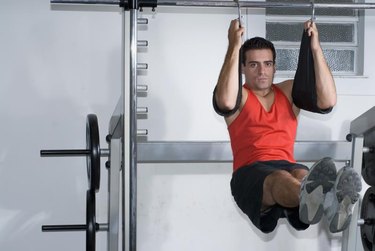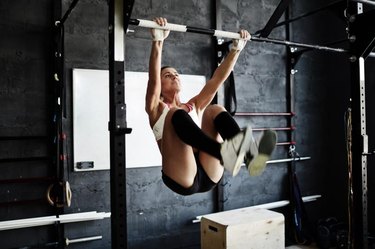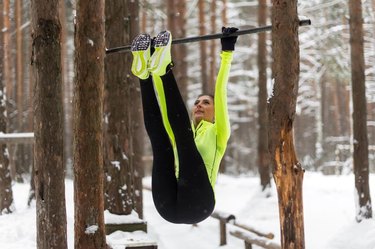
Hanging sit-ups, usually referred to as hanging leg raises, are often touted as the pinnacle of ab training and fitness. You hang from a bar, feet dangling, and crunch by drawing your knees and hips up to your chest. You feel the move burn and assume you're crafting a rock-hard belly, but actually, you're primarily working your hip flexors.
Hanging sit-ups can be part of a total core training routine, but don't rely on them as your only ab exercise.
Video of the Day
Video of the Day
Read More: The 41 Hardest Ab Exercises

Bent Knees vs. Straight Legs
There are two types of hanging leg raises. The first version has you pull your knees up to your chest, which primarily activates the illiopsoas, or hip flexors. The abs work as stabilizers, not as primary movers.
A harder version of the hanging leg raise involves keep your legs straight as you bend your hips to bring the legs to touch the bar from which you are hanging. The straight-leg variation does primarily activate the rectus abdominis, which is the front band of your abdominal muscles.
Research published in a 2015 issue of the Journal of Sports Sciences showed that the hanging straight leg raise challenged the abs the most, when compared to other exercises including the body saw and a walkout from a push-up.

Possible Back Pain
The hanging sit-up/leg raise may be effective, but it comes with possible side effects. When you work your hip flexors a lot, they become tight and strong, which pulls on the muscles of the lower back. This can lead to back pain, stress and even injury.
Any crunch-like ab exercise involves the hip flexors, though, so it doesn't mean you have to leave them out of your workouts. As long as your back is healthy and the hanging leg raise doesn't cause pain, it's an effective part of an ab routine.
However, include other moves such as front planks, side planks, anti-rotation moves, wood chops and back extensions to create a balanced core that doesn't have too much strength in the hip flexors.
Tips for the Hanging Leg Sit-Up
Proper form helps you get the most out of the hanging leg sit-up or straight leg raise. Improve the stability of your grip by grasping the bar with an overhand grip and tucking your thumbs around the bar so that they hook over the first two fingers on each hand. Focus on keeping your shoulders pulled down your back, rather than edging up toward your ears.
When you do crunch your knees up to your chest or your legs straight up to the bar, retract your ribs. This helps you move using your hips and abs, rather than using momentum from your lower back. Remember to breath as you do the exercise, too; exhale forcefully as you bring the legs up.